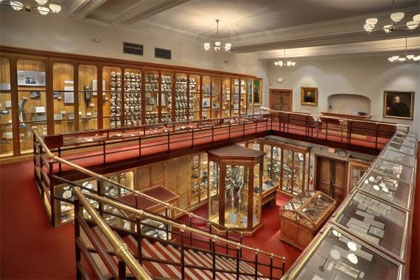
The Bizarre Mütter Museum and its Mysterious Giant Skeleton
Brent Swancer April 21, 2021
Located in the Center City area of Philadelphia, Pennsylvania, the Mütter Museum is without a doubt one of the creepiest and macabre museums out there. Part of the college of Physicians in Philadelphia, it has been displaying a large range of medical oddities, anomalies, and grotesqueries, weird specimens, wax models, and all manner of bizarre medical equipment and tools, as well as a large collection of books called the Historical Medical Library since the collection first began in 1858 with a donation from Dr. Thomas Dent Mutter. There are over 20,000 individual objects available for display here, many of them in turns haunting, revolting, fascinating, and at many times mysterious.
The museum boasts over 3,000 osteological specimens including skeletons and skulls, 1,500 wet specimens covering just about every part of the body and every type of cyst or tumor, and various others, which really run the range between odd and downright disturbing. Some of the more famous attractions here include slices of Albert Einstein’s brain, the liver and plaster torso death cast of the famous Siamese conjoined twins Chang and Eng Bunker, a malignant tumor removed from President Grover Cleveland’s hard palate, a sample of thoracic tissue removed from John Wilkes Booth, the assassin of President Abraham Lincoln, a chunk of the brain of Charles J. Guiteau, the assassin of President James A. Garfield, and the corpse of the “Soap Lady,” known for the coating of fatty substance over her body that makes her look to be made of soap. There is also a giant, grossly distended human colon, a product of Hirschsprung’s Disease, a wall decorated with 40 diseased and injured eye-balls, a wall of misshapen, deformed, or otherwise curious skulls called The Hyrtl Skull Collection, two-headed human fetuses at various stages of development, and a collection of books bound in human skin, among others.
 The Mütter Museum
The Mütter Museum
One of the more mysterious exhibitions in the museum can be seen in the skeleton exhibit. Here among the skeletons of dwarfs, deformed freaks, and various other conditions is a towering specimen that is called “The American Giant,” strategically positioned between a normal sized human skeleton and that of a dwarf. The skeleton itself is the tallest skeleton put on display in North America, coming from an individual who is estimated as having been about 7 feet, 6 inches tall, although since the spine has an abnormal curvature the actual height would have been even taller if it was straightened out. It is an impressive specimen, indeed, but even more so in that the story of its arrival in the museum’s collection and its actual identity are shrouded in mystery.
In 1877, a Professor A.E. Foot approached the museum claiming that he had found a giant for sale in Kentucky, something which piqued the interest of a Professor Joseph Leidy, who wanted to purchase it for the museum’s collection. Oddly, Foot made the stipulation that in order for the sale to go through, there could be no questions asked about where the skeleton had come from or how it had come to be up for sale in the first place. This all seemed pretty shady, and indicated that the skeleton had probably been procured in less than savory ways, but Leidy wanted it, needed it, had to have it, and so he agreed and pushed ahead with the purchase. And so The American Giant arrived at the Mütter Museum to wow and amaze people all the way up to the present, but there is relatively little known about who it actually was. It is thought that the individual was male and perhaps between 22 to 24 years old at the time of death, and that he had probably lived in Kentucky, and there is evidence he had agromegaly, which is abnormal growth of hands, feet, and facial features, as well as signs that he had been bedridden for some time before death, and that is about it. No one really knows any more than that, but there has been much discussion to this day as to who the massive skeleton belonged to.
 The American Giant skeleton
The American Giant skeleton
One idea that has been proposed is that these are the remains of a man named James Toller, of Huntington, England. Also called “The Enyesbury Giant,” Toller stood 8 feet, one and a half inches high, and died at the age of 23. The story goes that he was buried under a church, and that when the church was renovated in the 1870s someone may have stolen the body and whisked it off to the States to sell it. At the time, grave robbing was pretty big business, with corpses often dug up and sold to medical institutions on a no questions asked basis, so it is quite possible. The problem is that Toller was much taller than the American Giant, even when adjusting for the spine curvature, so who else could it have been?
Another idea is that it could have been a man named John M. Baker of Caldwell County, Kentucky, who died in 1861 in his early 20s. The fact that he was a local of the same state where the skeleton was up for sale bolsters this case, as does his height, estimated to have been around 7 feet, 8 inches tall. Again, it is thought that grave robbers might have dug the body up to sell it, and considering the location and similarities in height, Baker seems to be a good candidate. It could have also been a supposed giant inmate at the East Bethany-Genesee County Poorhouse in New York state, who was called simply “Roy.” If he had died while incarcerated it does not seem to be beyond plausibility that nefarious parties would want to make a buck off his giant frame. The problem is, no one is sure just how tall Roy really was, and it has been suggested that he may have died long after the American Giant skeleton came into the museum’s possession.
The American Giant could have also been an unknown giant, but considering how much of a rarity such height was at the time and how much they stuck out, people of these sizes were typically well-known and unlikely to be able to live completely anonymously off the grid. It should be a simple matter of cross-checking known giants who died within a specified time period, yet over a century later no one knows who in the world the American Giant of the Mütter Museum was, whoever may have known having long ago taken the secret to the grave with them. In the end, we have no way of knowing, and it is a strange mystery at an already strange place.
MU*


















